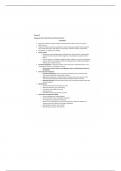Chapter 47
Management of Pt with intestinal and Rectal Disorders
Constipation
• Fewer than 3 bowel movements weekly or bowel movements that are hard, dry, small, or
difficult to pass
• People more likely to become constipated are women, particularly pregnant women, patients
who recently had surgery, older adults, non-Caucasians, and those of lower socioeconomic.
• Constipation is a symptom not a disease.
• Causes include
o Medications: anticholinergic agents, antidepressants, anticonvulsants, antispasmodics
(muscle relaxants), calcium channel antagonists, iron preparations, opioids, diuretic
agents
o Chronic laxative use, weakness, immobility, fatigue, inability to increase intra-abdominal
pressure, diet (low consumption of fiber and inadequate water intake), ignoring urge to
defecate, lack of regular exercise
• Perceived constipation: a subjective problem in which the person’s elimination pattern is not
consistent with what he or she believes is normal
o Chronic use of enema, laxative, and suppository abuse are defining characteristics of
this problem
• Three classes of constipation
o Functional constipation: involves normal transit mechanisms of mucosal transport.
Successfully treated with increased fiber and fluid.
o Slow-transit constipation: caused by inherent disorders of the motor function of the
colon (Hirschsprung disease), characterized by infrequent bowel movements
o Defecatory Disorders: caused by dysfunctional motor coordination between pelvic floor
and anal sphincter
• Manifestations
o Fewer than three bowel movements per week
o Abdominal distention, pain, and bloating
o A sensation of incomplete evacuation
o Straining at stool
o Elimination of small-volume, hard, dry stools
• Assessment and Diagnostic Findings
o Chronic constipation is usually idiopathic
o Further testing for severe, intractable constipation
o Thorough history and physical examination
o Barium enema, sigmoidoscopy, and stool testing (used to determine whether this
symptom results from spasm if narrowing of the bowel)
o Defecography and colonic transit studies
o MRI (identify occult pelvic floor defects)
, • Complications
o Decreased cardiac output
▪ Straining results in the Valsalva maneuver (forcibly exhaling with the glottis
closed), decreases BP. This leads to collapse of large vein in the chest.
o Fecal impaction
▪ Occurs when accumulated mass of dry feces can’t be expelled. May produce
pressure on the colonic mucosa that results in ulcer formation and may cause
fecal incontinence, with seepage of liquid stools
o Hemorrhoids: dilated portion of anal veins
o Fissures: normal or abnormal folds, grooves, or cracks in body tissue
o Rectal prolapse
o Megacolon: dilated and atonic colon caused by a fecal mass that obstructs the passage
of colon contents. Can lead to perforation of the bowel.
• Medical Management
o Education, exercise, bowel habit training, increased fiber, and fluid intake
o Patient can be educated to sit on the toilet with legs supported and to utilize the
gastrocolic reflux (peristaltic movements if the large bowel occurring 6 times daily that
can be triggered by distention of the stomach)
o Dietary intake of 25 to 30 g/day of fiber (soluble and bulk forming)
Diarrhea
• Increased frequency of bowel movements (more than three per day) with altered consistency
(i.e., increased liquidity) of stool
• Usually associated with urgency, perianal discomfort, incontinence, or a combination of these
factors
• May be acute: Self-limiting lasting 1 to 2 days; caused by viral infections (Norwalk virus)
o Persistent: lasts 2 to 4 weeks
o Chronic: persists more than 4 weeks and may return
• Causes include infections, medications (erythromycin, magnesium – containing antacids, tube
feeding formulas, metabolic and endocrine disorders, and various disease processes
• Chronic diarrhea may be caused by adverse effects of chemotherapy, antiarrhythmic agents and
antihypertensives.
o Endocrine disorders: diabetes, Addison disease, thyrotoxicosis
o Maladaptive disorders (lactose in tolerance, celiac disease
o Anal sphincter defect: Zollinger Ellison syndrome
• C. Difficile the most commonly identified agent in antibiotic-associated diarrhea
Manifestations
o Increased frequency and fluid content of stools
o Abdominal cramps
o Distention
o Borborygmus: rumbling noise caused by the movement of gas through the intestines
o Anorexia and thirst
o Painful spasmodic contractions of the anus




